Hidden Agenda for Demographic Change in Trincomalee
by D.B.S. Jeyaraj, Transcurrents, October 20, 2007
| My criticism on this issue is about the state acting as the agent of the majority community alone and attempting to transform the demographic composition of areas as a politico-military project. It is seeking to impose majority hegemony and convert the non – Sinhala people of those regions into a minority. What is worse is that this is being done after the people of the East lie bruised and battered by a cruel military campaign. The vulnerable civilian population remains utterly helpless after the “shock and awe” tactics and is unable to articulate any effective protest even as its historic habitat is usurped by the mighty state…Just as Anuradhapura was declared a sacred zone by SWRD Bandaranaike and the Tamil dominated “old” town gave way to the Sinhala “new” town the Tamil Trinco town of “old” will be replaced by the “new” Sinhala Trinco. |
The “Panchamahabalavegaya” or five great forces that brought SWRD Bandaranaike to power in 1956 comprised the Buddhist priests, Ayurveda physicians, teachers, agriculturists and workers. There is a “Nava Panchabalavegaya” at work now that seeks to “Sinhalaise” Trincomalee district in particular and the Eastern Province in general. The new five forces striving to alter Eastern demography consists of sections of the Buddhist clergy, security forces, bureaucrats, politicians and business persons.
The last official census for North – East was in 1981. The 2001 National census was not conducted in seven of the eight districts in the North and East. As such exact population figures are not available. In 2006 an estimate was tabulated from figures provided by the respective district Kachcheris. According to these figures, the Eastern Province population was 1 , 607, 971. Of this Tamils were 674,411; Muslims 573,843 ;Sinhalese 352,866; and others 6,851.
Trincomalee district had 412, 547 people. Of these 168, 696 were Muslims;143,282 Tamils, 100,454 Sinhalese and 115 others. Batticaloa district had 565,780 people. Of these 415, 217 were Tamils,145,349 Muslims,1,246 Sinhalese; and 3,968 others. Amparai district had 629,644 people; of these 259,798 were Muslims;251,166 were Sinhalese;115,912 were Tamils; and 2,768 others.
These figures have changed now as more than 20, 000 Tamils have left Trincomalee district in the past year. More than 15,000 went to Tamil Nadu as refugees. Others have relocated to Colombo and other areas in the South and also gone abroad.
There has for a long time existed extremist elements among the Sinhalese who wanted to populate the East with Sinhalese and change the demography. Trincomalee district has been a specific target. The late RG Senanayake, for instance, advocated the “Sinhalaisation” of Trincomalee and even contested elections there in 1970. He was defeated.
What has happened after Mahinda Rajapakse became president is that these extremist elements are now ensconced in seats of power. “Sinhalaisation” through demographic transformation is no longer a dream of the fringe elements. It is now part of the undeclared yet potent “chinthana” for the Country. Powerful forces are at work with the full blessings of the regime to implement a hidden agenda.
Apparently, the objective of this hidden agenda for demographic change is to make Sinhala speaking people the single largest ethnic group in the Eastern Province. According to plans, the Sinhalese population will increase over the years in Trincomalee and Amparai to become the dominant entity in those districts..It would substantially increase in Batticaloa.
Trincomalee is the key target. The pressure would be exerted on Tamils in Trincomalee to move out gradually. The economy of Tamils and Muslims will diminish through calculated manoeuvres while state input will help develop the economy of Sinhala people in the province.
At the outset let me state very clearly that all citizens in this country have the freedom to reside in any place they wish to live. The state is duty-bound to protect them. This country belongs to all of her people and deliberately fostering ethnic enclaves is not desirable.
Philosophically I would say that land does not belong to people but people to the land. It is also a fact of life that certain ethnic groups have lived for generations in particular regions and regard them as their areas of historic habitation. Yet this does not give them an exclusive right to those areas
Another reality in Sri Lanka is that people of all ethnicities are living in all parts of the Country. This population distribution has been uneven and does not reflect the overall population ratio. It is an undeniable fact that ethnic groups in this country are a majority in certain districts and a minority in other districts.
Thus the Tamils dominate the Northern Province and are the largest group in the East. Until the escalation of the war, nearly two – thirds of Sri Lankan Tamils lived in these two provinces. One – third of the Muslims lived in the East. The Sinhala people are the majority community in the Island and dominate seven provinces but form only a “minority” in the North and East.
Tamil political discourse speaks of the North and East as the “traditional homelands of the Tamil – speaking people”. The “Tamil – speaking” concept includes Muslims. The North and East are large, underpopulated provinces with large chunks of the sea coast.
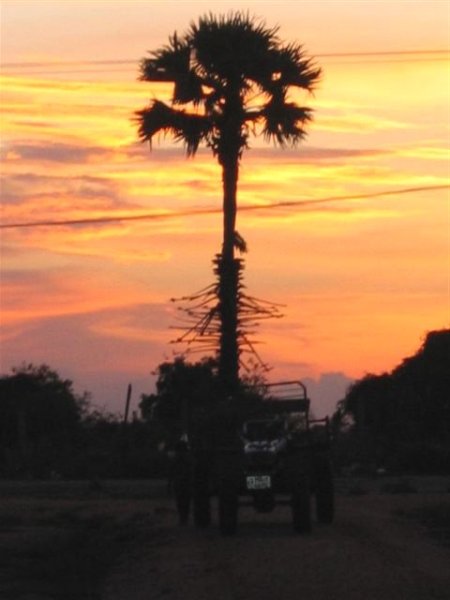
[Sunset in “Iqbal Nagar”, Thamaraikulam, Nilaveli-Trincomalee District]
If one detaches from emotion and views it from a reason-based perspective alone, it would appear that a minority segment population of one – eighths cannot indefinitely “hold” on to a region consisting of one – thirds of the total landmass and two – thirds of the coastline. This is sheer arithmetic!
So there would have been internal migration from “Sinhala” areas to the North – East just as people of the North – East migrated to the South. Colombo being the national capital was common to all people and not the exclusive preserve of any single community. It is a common phenomenon to see major cities having a multi-ethnic population. This is the case in Colombo too.
People moving from one place to another of their own volition is not wrong. What is wrong however is the intervention of the state in moving people of a particular ethnicity on a large – scale into areas where people of another ethnicity are living in large numbers for generations. The problem becomes more acute when the state’s intention is to deliberately alter the existing demographic patterns.
Unfortunately for Sri Lanka, this is what happened and the issue became politicised. The state became majoritarian friendly. State-sponsored schemes were set up to populate areas in the East with Sinhala persons. The demographic patterns of the province transformed drastically.
This was not a case of natural transformation but an artificially engineered one. It was a political project whereby the population in these provinces was deliberately altered with ulterior motives. The Tamils and Muslims resented this politics of colonisation.
Tamils and Muslims of the East were also given lands but this was only a small percentage of lands allocated to Sinhala settlers brought from outside the province. Communal violence was directed against Tamils and many were driven out. Other forms of discrimination were also practised against Tamil and Muslim settlers while the state machinery strained itself to help Sinhala settlers. Apart from lands given legally illegal encroachment was also encouraged.
It is against this backdrop that contemporary designs on altering demography have to be viewed. There have been several attempts in this respect during the past. Some were successful and others not. But what is being planned now is a well-coordinated long term project to “Sinhalaise” or make Sinhalese the dominant entity in the East in general and Trincomalee district in particular.
This plan has backing right at the top and involves sections of the Buddhist clergy, security forces, bureaucrats, businesspersons and politicians.
Once again I wish to emphasise that my criticism of this plan is not based on the traditional homeland theory or due to opposition to Sinhala people relocating to Tamil areas. As someone who was born in Colombo and lived for the greater part of his life in the South and as one living now abroad, my worldview cannot be parochial.
It has been my experience and privilege to enjoy the multi-ethnic life of Colombo and Toronto. This diversity is something to celebrate and not resent. Cordial Interaction of different ethnicities is a blessing in practice.
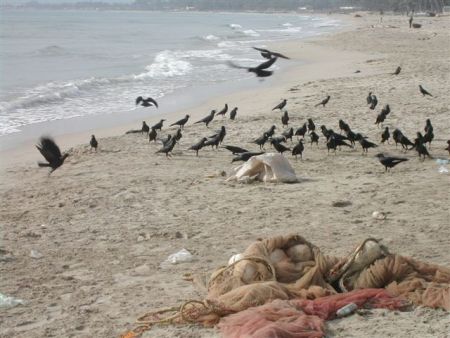
[Crows on the shore, in Uppuveli, Trincomalee – Pic: HumanityAshore]
My criticism on this issue is about the state acting as the agent of the majority community alone and attempting to transform the demographic composition of areas as a politico-military project. It is seeking to impose majority hegemony and convert the non – Sinhala people of those regions into a minority.
What is worse is that this is being done after the people of the East lie bruised and battered by a cruel military campaign. The vulnerable civilian population remains utterly helpless after the “shock and awe” tactics and is unable to articulate any effective protest even as its historic habitat is usurped by the mighty state.
A protracted 15-month military campaign has seen the Eastern Province coming under Colombo’s writ. From Pulmoddai to Panamai, there is no area controlled by the Liberation Tigers of Tamil Eelam (LTTE) now. The Government of Sri Lanka boasts of having liberated the East.
More than 200,000 people were displaced and much of their dwellings destroyed or damaged. Agriculture, fisheries, dairy farming etc of the Tamils are in shambles. Education, sanitation, health, housing etc are severely affected. What is immediately necessary is to address these needs and restore normalcy. The state has been notoriously lax in this and if not for NGO assistance the people would be in a terrible plight.
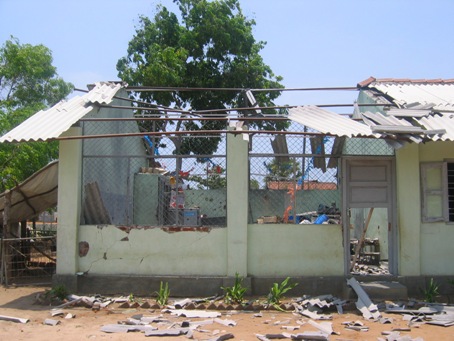
[Sampoor Srimurugan Vidyalayam (school) in Trincomalee, damaged from the April, 2006 air attack]
Instead of prioritising the needs and concerns of the affected people the Rajapakse regime has grandiose plans of developing the province through ambitious projects. The President talks of 20 billion rupee projects while his brother Basil Rajapakse heads these efforts to make the East “awaken and rise”.
This writer has in earlier articles pointed out the exclusion of Tamil in policy announcements and propaganda about these Eastern development projects. The Province is 75 % Tamil speaking but the Tamil language is pointedly omitted in official documentation pertaining to these schemes.. This does not seem an unwitting error but wittingly symbolic.
The master plan devised to develop the East is actually an important component of the hidden agenda to alter demography. The emphasis on Sinhala in a predominantly Tamil speaking region is not merely an exhibition of callous insensitivity but a pointer to the future where the east is going to be “Sinhalaised”.
These plans envisage among other things demographic changes through tourism development and Buddhist revival in Amparai district and agro-business promotion in the Kudumbi malai/Thoppigala areas coming under System B Maduru – Oya scheme in Batticaloa district.
But Trincomalee for many reasons is the prize target and receives top priority in the Sinhalaisation project. I will therefore focus on Trincomalee alone in this article.
Facts and figures from census statistics about population growth in Trincomalee district will help illustrate how demography patterns are unnaturally altered or distorted through state sponsored colonisation.
In 1881 the Sinhala population of Trincomalee district was only 935 or 4. 2 %; the Tamils were 14,394 or 64.8 % while Muslims were 5746 or 25.9 %.
100 years later in 1981 the Sinhalese were 86,341 or 33.6 % but the Tamils were 86, 743 or 33.7%. The Muslims were 74, 405 or 28.9 %.
In a century the Sinhalese had gone up from 4. 2 % to 33. 6 % and Muslims from 25.9 % to 28.9% but the Tamils had decreased from 64.8% to 33.7.
In a hundred years the Tamil population increased 502 % and Muslims 1068 % but the Sinhalese had gone up 9134%. While the Muslim increase of double the Tamil percentage can be attributed to larger families and greater birthrate the astronomical increase of Sinhala percentage was primarily due to colonisation…
This distorted demographic transformation being accelerated in the post – Independence years through colonisation is further illustrated through other statistics.
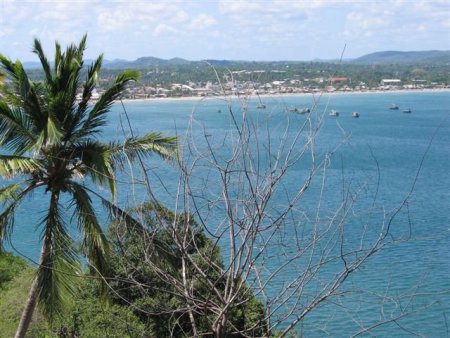
[View from Swamy rock, Trincomalee – Picture by Dushiyanthini Kanagasabapathipillai]
From 1953 to 1981 the Sinhala population of Trincomalee town and gravets AGA division increased 210 % but Tamils and Muslims increased only 109 %; In Seuwila and Mutur AGA divisions the Sinhala increase was 291 % while the others were only 143%; In Thambalagamam, Kinniya and Kanthalai the Sinhala increase in 28 years was 1180% while the others increased 183 %. In Kuchaveli, Gomarankadawala and Morawewa the Sinhala increase was 580% and for the others 190 %.
Apart from the distorted demographic transformation through colonisation, there was another reason for Trincomalee being made to change. It was of strategic importance due to its natural harbour and the [oil] tank farm. It was also in the North – East and the Federal Party spoke of Trincomalee as the capital of a Tamil state. This made Trincomalee important in a politico-military sense. Later during demonstrations like “pongu Thamil” (Tamil upsurge ), LTTE elements crowed about Trinco being Tamil Eelam’s capital.
Under these circumstances, Sinhala fears and insecurities were revived. The presence of artillery in Sampoor saw Trincomalee harbour coming under LTTE threat. It became a politico – militarily imperative from a Sinhala dominated state’s perspective to undermine tiger and by extension the Tamil presence in the district.
Thus it was inevitable that plans would be laid both to interdict Northern and Eastern territorial contiguity as well as de – Tamilise Trincomalee and Sinhalaise it.
The escalation of the ethnic conflict saw the Trincomalee district suffer. Many massacres occurred and Tamil civilians were killed. Thousands fled to India and elsewhere.
Sinhala civilians were militarized through the home guard scheme. The Sinhalese were chased out in large numbers during the Indian army period.
Later there was a strategic equilibrium between the LTTE and GOSL forces. Now that the LTTE has been driven out and the GOSL holds the whip hand attempts are on to impose a Sinhala supremacist agenda on the diminished Tamils of Trincomalee.
The Sinhala supremacist vision of Sinhalaising Trincomalee has been invigorated with politico-military imperatives now. There is a need to break up North – Eastern territorial contiguity, safeguard strategic places like the harbour, airport, prevent Trincomalee from becoming the Tamil Eelam capital and exploit the district’s economic potential.
Rajavarothayam Sambandan, the Veteran Tamil politician and Tamil National Alliance MP from Trincomalee district, charged in Parliament on Sep 5th about a conspiracy to carve out a new district comprising northern parts of Trincomalee district and Southern parts of Mullaitheevu district.
This was a device to break North – Eastern contiguity, Sambandan stated. This was denied and Karu Jayasuriya assured Sambandan that there was no plan to create a new district.
Though Sambandan helped highlight some of the sinister designs on Trincomalee he was apparently wrong about a new district.
It is true that there was an earlier plan to create a new district called Weli – Oya consisting of areas ranging from Padaviya in the west, Kokkilai in the east, Thennamaravaady in the South and Nedunkerny in the North.
This was the “chinthana” of people like Lalith Athulathmudali, Gamini Dissanayake, Ranjan Wijeratne and Anuruddha Ratwatte. Tamils from 28 villages were driven out in an act of ethnic cleansing by the state. The Weli – Oya district would break North – Eastern [electoral] contiguity.
But the Rajapakse regime does not seem to entertain that idea now. One reason for this is that a bill has to be presented and two – thirds majority obtained to create a new district.
Apart from the difficulty of getting two – thirds such an act will be universally condemned due to its blatant Sinhala hegemonist design. This, however, is not the only reason why this regime has shelved the new district plan.
The earlier idea envisaged Trincomalee as a Tamil – speaking district and therefore thought of a new district as a wedge. But this regime wants to convert Trincomalee itself into a Sinhala majority district by altering demography through Sinhalaisation. If current plans are implemented then Trincomalee will become the Sinhala district interdicting Northern and Eastern contiguity.
As time progresses further Sinhalaisation will transform the entire Eastern province into a Sinhala majority province. There will be no need to break territorial contiguity or consider the merger of provinces then. Instead of creating a new district, the existing one will be demographically altered.
The recent pattern of certain events indicates what future lies ahead for Tamils and Muslims in the district. The Sampoor region including 12 villages has been made a high-security zone. People are barred from re-settling in their ancestral villages. Tamils and Muslims are not allowed to fish or farm in certain areas.
In Ilankaithuraimuhathuvaaram Tamils are prevented from re-settling while plans are afoot to make it the “sacred” area of Lanka Patuna.
In Jabalmalai Muslims and Tamils are barred from quarrying. Apart from unemployment, the people will now have to buy granite at exorbitant prices from Sinhala businessmen in Kanthalai.
Housing schemes are set up and families of Sinhala security forces enlisted from the district are being settled in places traditionally inhabited by Tamils and Muslims like Iraalkuli and Kappalthurai.
Prominent Tamils with leadership potential are being assassinated to demoralise the civilians further. There is a growing nexus between Sinhala civilians and the security forces. Sinhala youths from the district are being enlisted in large numbers into various branches of the security apparatus. Sinhala civilians were aided and abetted by the security forces in looting houses of fleeing Tamil refugees and appropriating livestock.
More important however are master development plans in the pipeline. One is the Trincomalee metro centre urban development plan. This is an integrated development plan for Trincomalee town and other outlying areas.
Trincomalee town is currently Tamil dominated. When this plan comes into force a substantial number of Tamil people will be evicted. Further relocation will be necessitated in the name of security by declaring a security zone around the harbour and adjacent coastal areas.
Just as Anuradhapura was declared a sacred zone by SWRD Bandaranaike and the Tamil dominated “old” town gave way to the Sinhala “new” town the Tamil Trinco town of “old” will be replaced by the “new” Sinhala Trinco.
The other is the comprehensive Post -Resettlement Development plan for the Eastern region. Displaced Tamils are being cruelly shuttled about and re-settled without any facilities or infrastructure. They are treated as statistics and not human beings.
The haste is to complete “re-settlement” on paper and then move on to massive post – resettlement development projects. Apart from minting money (more than 10 % of costs ) through corrupt practices the last refuge of scoundrels – patriotism – is also being resorted to. The master plan will facilitate the Sinhalaisation process.
Some of the proposed projects for Trincomalee under this plan are the special economic zone at Kappalthurai. The first phase costs 4250 million and second 2600 million rupees. It will be completed in 2015. There will also be a small and medium industrial zone at Kappalthurai. The first phase costs 500 m and the second 1000 million rupees. It will be set up in 2008.
A new administrative secretariat will be established at Mankaiootru for 300 million rupees in 2008. A new fisheries harbour costing 1000 million rupees to be constructed by 2010 at Pudavaikattu. A new town development scheme for Andankulam – China Bay to be built by 2010 for 1500 million rupees.
A massive road project linking Uppuvely and Eechilampatru to be constructed by 2010 for 10. 3 billion rupees. This proposed outer circular road will run through Sinhala areas of Seruwila division. This is an extension of a new road being constructed now in Trinco North. Two tourist resorts will be set up by 2010. They will be in Nilaweli and Verugal at a cost of 800 million and 1750 million rupees respectively.
An important project in this respect is the coal-fired power plant to be set up with Indian assistance. Both phases of the project are expected to cost 500 million US dollars each and will be completed by 2012. Originally it was earmarked for Kappalthurai but Colombo wanted to set it up later in Sampoor. But New Delhi has stood firm and it is likely to come up in Kappalthurai
There are also plans to develop a tourist site around the hot water wells at the Tamil village of Kanniya and Sinhalaise it. An industrial zone is to be set up in the phosphate-rich Muslim area of Pulmoddai. The area is to be renamed Polmadhu.
The GOSL has called for foreign assistance and private sector investment to develop Trincomalee district. The project plans do not refer to ethnicity but only to people. Tamils and Muslims will also be given employment in projects. But these will be of a “token” nature to avoid charges of ethnic discrimination.
In actual practice there will be an ethnicised approach and employment will be given mainly to Sinhalese from the district and outside. The thinking is that the strategically important Trincomalee’s security can be ensured in the long run through an enhanced security force presence. The security of this military presence can be ensured through a sympathetic population. A sympathetic population can be guaranteed only through Sinhalaisation. Greater recruitment of Sinhala youths from the district into the forces and facilitating settlement of families in the district can strengthen security further.
New Sinhala settlements will come up. Already thousands of Sinhala youths from Trinco are being incorporated into the security forces. Housing schemes are being set up widely. Security force members from outside the district are encouraged to settle families in Trincomalee.
Actual settlement of Sinhalese civilians from outside the district is yet to take place on a massive scale. But preparations are on. Sections of the Buddhist clergy affiliated to a hardline political party are now compiling lists of people from different parts of the Country who are willing to settle down in Trincomalee.
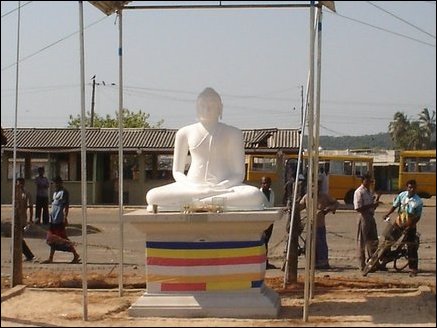 |
| Newly erected Buddha statue near the Trincomalee bus terminal. TamilNet, May 17, 2005 |
It is only a matter of time before the great Northeastern trek commences. The groundwork is being laid cleverly for future Sinhalaisation. The state machinery is being mobilised. It will be a slow process and would depend on the militarisation process and progress of economic development. A key element in this is the opening up of new roads.
The Road Development Authority (a central agency) which is in charge of A and B class roads under the 13th Amendment has begun constructing an inner ring road and an outer ring road for Trincomalee. The inner ring road links Aathimottai on the Trincomalee-Nilaveli- Pulmottai Road, Kanniya on the A12 (Puttalam- Anuradhapura-Trincomalee Road) and 189km post on A-6 (Kandy-Habaran- Trincomalee Road).
Arrangements are being made to get Sinhalese “encroachers” to move in between A-6 and A12 on this ring road. Basil Rajapakse is personally overseeing this project.
The outer ring road planned will begin at Kuchchaveli on the Trincomalee- Nilaveli-Pulmottai Road, cross A12 near Pankulam and meet A6 between Kantalai and Tampalakamam and proceed to Ilankaiturai -Muhathuvaram and to Sampur in further phases.
Sinhalese had already been settled near Pankulam and on the A6 between Kantalai and Tampalakamam. The Tamils who had been living there had been chased away since the early 1980s. Now, the programme is to bring in more Sinhalese and settle them between the two ring roads. Workers on new projects will be mainly Sinhalese.
The construction work is being undertaken by the SL Army. The RDA Chief Engineer in Trincomalee works very closely with the SL Army. The planning and design are done in Colombo. The Provincial Director of the RDA is based in Batticaloa. He is completely in the dark about the two ring road projects.
Minister Abdul Majeed who is from Kinniya and who belongs to the All Ceylon Muslim Congress of Rishad Bathurdeen is allegedly backing these projects for reasons of his own. Funds are provided from the Nation Building Ministry under President Rajapakse.
During the past Sinhalese were settled through land allotments in irrigation schemes. At present, the main irrigation settlement scheme envisaged is system M lands of the Yan Oya/Kallaru basin to the north of Trincomalee. Earlier in 1983, Gamini Dissanayake settled 3364 Sinhala families on lands under System L in the Weli Oya /Manal aaru region. Now the plan is to consolidate Yan Oya.
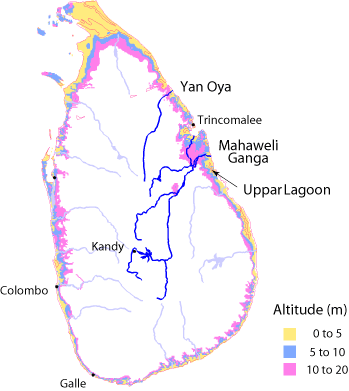 But there are other plans to in Trincomalee to alienate land through systemic encroachment. The new roads being constructed in Trincomalee north and the extended highway to be constructed in Trincomalee south will facilitate this.
But there are other plans to in Trincomalee to alienate land through systemic encroachment. The new roads being constructed in Trincomalee north and the extended highway to be constructed in Trincomalee south will facilitate this.
Some of the proposed development activity will certainly benefit Tamils and Muslims. But the lion share will be for people of the lion. Moreover, the project will ultimately lead to strengthening the Sinhala community and disempowering the Tamil – Muslim people of the district.
Sinhala People will be brought in as squatters in “new” territory opened up on either side of the roads. The security forces will help set up shelters, provide food and water etc under the pretext of providing security. After a short period of residence (not more than a year) the encroachers will make applications to legalise their “illegal” ownership.
The position of land alienation and settlement is a little complicated in the North and East as the Provincial Council is defunct. Be it the Governor or PC administration, reference must be made to the GA in such a situation. The GA will refer to the provincial lands commissioner. If all parties concur legalising encroachments will be easily done.
In order to facilitate this legal “landgrab,” the administrative machinery is being Sinhalaised. The previous lands commissioner Ms Justina Muraleetharan was removed and former Kanthalai Divisional secretary Piyasiri appointed.
After demerging the North and East the EP administration is being ethnically transformed. Former Trincomalee GA’s Rodrigo and Nelundeniya are chief secretaries and Public administration secretary respectively. Former Matale GA, Udage is secretary of the provincial public services commission.
There are also many ex-servicemen in key posts. The Governor is rear admiral Mohan Wijewickrema. The GA is Maj Gen Ranjith de Silva. The rehabilitation coordinator is Maj. Gen Amaradeva. The secretary to the Governor is capt. Patrick Jayasinghe.
Appointing ex – servicemen to key administrative posts has been criticised by members of the administrative service. The harsh conduct of the Trinco GA has been deplored. But the fact remains that this combination of retired administrative and security officials is well – equipped to implement the Sinhalaisation process in Trincomalee.
Apart from aiding land grab activities the administrative functions of the district can be gradually Sinhalaised. Recruitment and transfers could be ethnic – oriented. Already there are many signs of Tamils and Muslims being sidelined and Sinhalese being given pride of place in the district and provincial administration. There are also the security authorities whose powers are considerable in administrative issues.
The stage has been set and we may be in for a fantastic show of seeing a region being demographically transformed for politico-military reasons. “Kizhakku” will set while “nagenahira” will rise.
Some would call this slow ethnocide and a crime against humanity. But then the best laid plans of men and mice can go awry at times. Que sera sera!
 Published: October 27, 2007 Published: October 27, 2007 |

Leave a Reply
You must be logged in to post a comment.